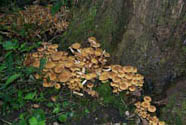Armillaria gallica
 Key to Gilled Mushrooms Key
Key to Gilled Mushrooms KeyThis is a key to gilled mushrooms, that is, mushrooms having a definite cap with a fertile surface consisting of gills. The fruiting body usually also has a stem, although that may be lateral or absent (usually, then, the mushroom is growing from wood). You can use this key to identify mushrooms that you find.
 Agaricales Order
Agaricales OrderFruiting body containing fibers (usually in the stalk)
 White Spored Suborder
White Spored SuborderSpore print "light-colored": white or buff, sometimes tinged with pink or tan. Greenish and (except for the Russulales) yellow spore prints also go here
Stalk fibrous, not fracturing like a piece of chalk
 Tricholomataceae Family
Tricholomataceae FamilyNone of the special features distinguishing the other white-spored genera:
Gills not free, as in the Lepiotas and Amanitas
Basidia not extra-long, as in the Hygrophoraceae
Spores smooth, except for Lentinellus
 Lignicolous Trich Subfamily
Lignicolous Trich SubfamilyGrowing on trees or dead wood, leaves, or sticks, or organic debris, often in moss
 Normal LignoTrich Tribe
Normal LignoTrich TribeShaped like a “normal mushroom”
Small and fragile to medium-sized, except for one large, grey-capped species
 Grey Brown LignoTrich Subtribe
Grey Brown LignoTrich SubtribeFruiting body medium-sized to large
Cap grey to brown, sometimes with radiating with dark brown to black fibrils
All else white or concolorous with cap
Growing on wood or duff
 Armillaria Genus
Armillaria GenusCap brownish or yellowish, or a mixture of either of those two with grey
Growth habit cestipose, sometimes in troops
Fibrils often quite dense in center of cap, sparser towards the margin
Annulus usually present
Black rhizomorphs
Armillaria gallica Marxmüller & H. Romagnesi
Here are the characters that distinguish this species from the others in its group. For its more general characters, see higher up on the page.
If there's just a few words or a microscopic feature here, a more thorough description can be found above.

Diagnosis

- Cap with brown squamules, most thickly on the disk, but these wash away in the rain






 Key to Gilled Mushrooms Key
Key to Gilled Mushrooms Key Agaricales Order
Agaricales Order White Spored Suborder
White Spored Suborder Tricholomataceae Family
Tricholomataceae Family Lignicolous Trich Subfamily
Lignicolous Trich Subfamily Normal LignoTrich Tribe
Normal LignoTrich Tribe Armillaria Genus
Armillaria Genus





